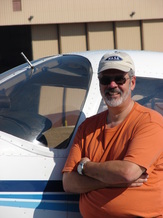Another instrument flight lesson today. Spent about 30 minutes on the ground asking my instructor questions for clarification from the ground school material I am studying. Then we briefed today's flight lesson.
We completed the preflight and taxied to Runway 33. With the run-up complete I donned the "hood" for another zero-zero take-off. This is the third time I have performed a zero-zero take-off and I guess I am getting used to it, because I was not the least bit apprehensive about it today. (Though it is still not natural to hurl yourself down the runway without looking at what is out there or whether you are still on the runway).
Settled into cruise flight in the practice area today was bumpy, difficult to hold a heading. I flew some slow flight with turns, climbs, and descents.
Back in cruise the bumpy air made it noticeably more difficult to hold a heading and I found myself "fighting" the airplane to keep it "wings level". Each time a bump would try to upset the balance of things, I would immediately react on the flight controls to counter what I was seeing on the panel. After awhile I realized the airplane would generally right itself from all but the most severe departures.
I later flew 20 or minutes of "partial panel" flight with both the Directional Gyro (DG)and the Attitude Indicator (AI) "failed" (covered). This was tough flying given the rough air. With no AI, we use the Rate-of-Turn gyro (electric gyro) and the magnetic compass to maintain level flight and direction. Not easy when the Rate gyro is dancing all over with the continual bumps. Using a VOR radial in conjunction with the compass made holding a heading easier than I anticipated.
We made a few more compass turns and timed turns, then called it a day with a localizer approach to Runway 33. Quite a workout but fun flying.
We completed the preflight and taxied to Runway 33. With the run-up complete I donned the "hood" for another zero-zero take-off. This is the third time I have performed a zero-zero take-off and I guess I am getting used to it, because I was not the least bit apprehensive about it today. (Though it is still not natural to hurl yourself down the runway without looking at what is out there or whether you are still on the runway).
Settled into cruise flight in the practice area today was bumpy, difficult to hold a heading. I flew some slow flight with turns, climbs, and descents.
Back in cruise the bumpy air made it noticeably more difficult to hold a heading and I found myself "fighting" the airplane to keep it "wings level". Each time a bump would try to upset the balance of things, I would immediately react on the flight controls to counter what I was seeing on the panel. After awhile I realized the airplane would generally right itself from all but the most severe departures.
I later flew 20 or minutes of "partial panel" flight with both the Directional Gyro (DG)and the Attitude Indicator (AI) "failed" (covered). This was tough flying given the rough air. With no AI, we use the Rate-of-Turn gyro (electric gyro) and the magnetic compass to maintain level flight and direction. Not easy when the Rate gyro is dancing all over with the continual bumps. Using a VOR radial in conjunction with the compass made holding a heading easier than I anticipated.
We made a few more compass turns and timed turns, then called it a day with a localizer approach to Runway 33. Quite a workout but fun flying.

 RSS Feed
RSS Feed